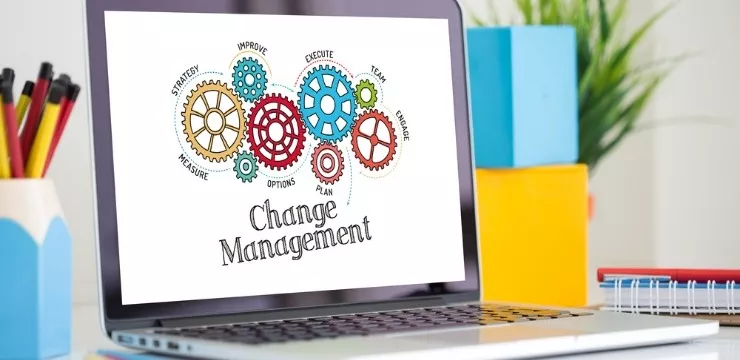
Changes to IT services can be difficult, trying, and exhausting. Change management methods — such as the ITIL change management process — removes headaches, speeds up the transition, and makes it easier for everyone involved.
So what exactly is ITIL and how useful is it?
A Quick Overview of the ITIL Change Management Process
The ITIL change management process is a framework that helps manage changes to IT services.
The goal is to reduce impacts to IT services and mitigate risk — after all, changes to IT services can impact business functions and the health of the business.
The framework involves standardized procedures for change implementation, through a process of:
- Requests and proposals for change
- A review and approval process for each requested change
- Detailed logs that track requests, changes, and outcomes
- Having a framework streamlines digital transformations and transitions to new technology.
A few advantages of the ITIL change management process include:
- Efficient handling of changes
- Reduced impacts to business functions during transitions
- Decreased costs of implementation
- Faster, more economical transitions
- A smoother, more enjoyable change process
Let’s go over the basics.
Who’s Who in ITIL
Before outlining exactly how ITIL changes are standardized, it pays to know who’s responsible for what.
Each company can assign its own roles as necessary, but key roles include:
- The Requestor – The person, team, or party requesting the change
- The Change Advisory Board – This group assigned the role of reviewing, evaluating, or authorizing changes. The role of approving changes can also be assigned to a separate individual.
- The Change Implementation Team – The group responsible for implementing the change
- The Change Manager – An individual or group of individuals that receive, prioritize, route, and evaluate risk associated with changes
The size of the organization will usually determine how many people are involved and what roles are assigned.
Smaller companies, for instance, may assign multiple roles to a single person or team.
Requesting Changes
The ITIL change management process is like an unopinionated web development framework. It gives you a set of rules and building blocks that you can use to build your own custom process.
One advantage to using a framework is that you don’t have invent your own process from scratch. Instead, you can rely on a change management toolbox that has been tried and tested by many others.
The first building block in the ITIL framework is the request itself.
The next building block is the request process. Requests are categorized as standard, normal, major, or emergency.
Standard changes are often already covered by existing policies and don’t require approval. The other three categories, however, should be submitted and reviewed.
Here’s how it works:
- A change is requested – Using a Request for Change (RFC), requestor submits it to the Change Advisory Board (CAB).
- The change is reviewed – The CAB evaluates the request, returns it for revisions if necessary, reviews it with other appropriate parties, and logs the request.
- The change is approved or rejected – Changes that are greenlit move forward to the implementation team.
Once the proposal has been approved, the real work begins.
The Key to Successfully Implementing Changes
Implementing changes is no easy task. It requires planning, testing, and ongoing evaluation.
Depending on the scope of the change, a new implementation team may need to be created. This team will work closely with the change manager, the IT manager, and other members of the change team.
One key to successfully implementing changes is planning.
This should be done during the request phase. And, if necessary, it should be pre-tested prior to approval.
After approval and testing, it is time for rollout.
During implementation, user feedback and testing can help pinpoint potential pitfalls. Pre-planning is also essential to reducing errors and bugs — and increasing the chances of success.
Once complete, the change should undergo a post-implementation review and monitoring.
Should Your Organization Test Drive the ITIL Change Management Process?
Unfortunately, “test driving” the ITIL change management process is not quite as simple as test driving a car.
Change management is a complex set of procedures that involve several groups of people. Just testing it out would require an investment of time and resources.
However, the benefits of ITIL are well-established, making it well worth the investment.
If your organization is implementing changes to IT services, then ask yourself a few question:
- Could these changes impact customer service?
- Could they result in service downtime or bugs?
- Could they impact business functions?
Ultimately, these types of errors can be costly and can impact the bottom line of a business.
Initiating a change management process, though costly, is often less costly than making changes without a change process.
Final Thoughts
Best practices such as those contained in the ITIL change management process are necessary, especially for larger organizations.
Initiating IT service changes without a framework such as ITIL simply doesn’t make sense.
It is important to remember that change initiatives aren’t always successful. Failed change initiatives can be very painful for the organization itself and for everyone involved.
Fortunately, with proper research, planning, and procedures, these pitfalls can be avoided.
The ITIL change management process is one method that can help you streamline change and ensure success.
WalkMe Team
WalkMe spearheaded the Digital Adoption Platform (DAP) for associations to use the maximum capacity of their advanced resources. Utilizing man-made consciousness, AI, and context-oriented direction, WalkMe adds a powerful UI layer to raise the computerized proficiency, everything being equal.



